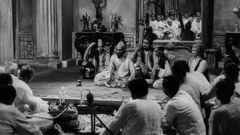
TIFF Cinematheque presents - Satyajit Ray
TIFF Cinematheque presents a landmark retrospective entitled The Sun and The Moon: The Films of Satyajit Ray, presenting one of the most important and influential bodies of work in international cinema with over 30 rare and restored features and shorts.
Running from July 3 to August 17, and curated by James Quandt, this major TIFF Cinematheque retrospective includes three of Ray’s monumental trilogies: The Apu Trilogy, which established the lyrical visual and narrative style with which Ray became identified; the Calcutta Trilogy, comprised of three of Ray’s skeptical, satirical, and politically engaged films; and The Final Trilogy, Ray’s final three films.
Also included are the superb chamber drama Days and Nights in the Forest (1969); Devi (1960), an intoxicating story about the conflict of old and new India as it is waged over the body and soul of a shy young bride; Charulata (1964), a moving examination of women's status in the colonial world of Victorian-era Bengal; and The Music Room (1958), one of Ray's most magnificently visual films.
Accompanying the Ray retrospective is Passages to India: India Seen by Outsiders, running from July 5 to 27, a provocative sidebar surveying the work of eight European and American filmmakers whose outsiders’ visions of India range from meditative documentary to delirious Orientalist artifice.
Full programme details at
http://tiff.net/cinematheque/the-sun-and-the-moon-the-films-of-satyajit-ray
Clip: https://www.youtube.com/watch?v=zkHR8rOg18Y
Capsule Review of selected films including the Apu Trilogy follows:
APARAJITO (India 1956) ****
Directed by Satyajit Ray
The opening credits state 1920 Benares. This is the second of Ray’s Apu trilogy and sees the boy in the coming-of-age. Apu must choose between his love for studies and his filial duty towards his ill mother. Everyone in Ray’s films are always ill, and this looks the case from the poverty and hygiene depicted in the eye-opening scenes. After living awhile in Benares, 10 year old Apu and his mother move in with her uncle in a small Bengali village. Apu enters a local school, where he does well. By the time he graduates, he has a scholarship to study at a college in Calcutta. So off he goes. Set in the 60’s, it is a bit dated though interesting to note that new technology is depicted by the burst of a flame in oxygen, an oscilloscope and other elemental scientific facts now taken for granted. Apu’s mother is torn by his leaving, and by his growing independence. This is a very powerful story of a hard life, how to cope the best one can and the tragedies that befall the poor.
CHARULATA (India 1965) ***
Directed by Satyajit Ray
Satyajit Ray’s most melodramatic movie about an unhappy wife of a successful publisher who falls in love with his brother, an academic devil-may-care lout who eventually leaves her for lack of commitment. All the usual details and Indian culture is present, as in Ray’s other movies. But the incident on hand is the love drama between the two lovers, which are distracted by several other subplots, like the re-education of the literary side of the wife. the political climate then (though this actually takes off the monotony of the noncommittal relationship) and the card-playing and the Indian parties. The tile that appears at the screen at the end of the film “The Broken Nest” seems like a cop-out ending. As much as I admire Ray’s films CHARULATA just does not do it for me, though it is beautifully shot.
DEVI (India 1960) ***
Directed by Satyajit Ray
Ray’s DEVI plays like a Shakespearean tragedy. It is 19th century rural Bengal, and Dayamoyee (Sharmila Tagore) and her husband Umaprasad (Soumitra Chatterjee) live with Umaprasad's family. The father, Kalikinkar Choudhuri, is a devoted follower of the goddess Kali. As Umaprasad is abroad at school, hell breaks loose when Dayamoyee takes care of her father-in-law. He believes her to be DEVI, an incarnation of the goddess. Ray’s film is rich in stunning cinematography of the countryside while providing a real scary look on religion. The images of the goddesses’ three eyes are the opening films’ credits are indeed scary. This is slow moving film that eats one emotions. DEVI is not an easy film to watch but it is nonetheless quite beguiling.
THE MUSIC ROOM (India 1958) ****
Directed by Satyajit Ray
The fiLm questions art above life. Is one is down on the last penny or gold coin in this instant, is it still worth to give a final concert in THE MUSIC ROOM? Ex-landowner Huzur Biswambhar Roy lives in a crumbling palace on the banks of a wide river, in the midst of an empty plain. His money is running out. For years he has had little to do, and only one passion, listening to concerts in his music room. His closest neighbour is despised moneylender Mahim Ganguly, a low-caste and vulgar, but hardworking and ambitious. Ray’s film tells of the rift between the two as highlighted in the climax of he third of the music performances in the music room. The film moves at a leisurely pace, as in all of ray’s films, and there is much to be observed in every detailed scene. The second music performance is hilariously funny while the third is mesmerizing. Ray also displays an Indian culture seldom seen on we tern screens. THE MUSIC ROOM is pure delight!
PATHER PANCHALI (India 1954) ***** Top 10
Directed by Satyajit Ray
Ray’s first film and my personal best of Ray’s Apu Trilogy. PATHER sees Apu as he is born and raised as a kid while his older sister steals guavas from the neighbourhood orchard much to the chagrin of their mother who is unable to control her. Their father is away on business trying to send home money to clear debts and repair their old house. Again, Ray’s film is a tragedy much inspiring in the way he evokes the human condition. He shows the good and bad of each of his characters, especially the mother. One scene has her beating up her daughter before throwing her out of the house and another at the end of the film hugging her crying when ill. But this is the first story of the hard life of Apu, how early childhood affects his adulthood in the later two films. Stunningly shot in black and white, PATHER is clearly one of the most moving and unforgettable films of all time.
THE WORLD OF APU (India 1959) ****
Directed by Satyajit Ray
The third and final of the Apu Trilogy is the most gut wrenching and emotional. Ray provides unforgettable scene such as the son throwing a stone at his father, Apu’s beautiful bride descending the stairs and Apu stretching out in the monsoon rains. Apu is grown up, and get hitched into a marriage that eventually works out for him. Apu and his bride develop the love of their lives. But as in Ray’s films, tragedy strikes. She dies giving birth to their son. Apu blames his son for her death and the rest of the film is his coming to term with the truth. Ray’s film is not easy to watch, like his others and this one even more so. But Ray offers his audience a slice of life rarely seen - in busy Calcutta and rural India. THE WORLD OF APU is a beautiful and stunning movie, no doubt and puts Ray up there as one of the greatest directors ever lived.









Comments powered by CComment